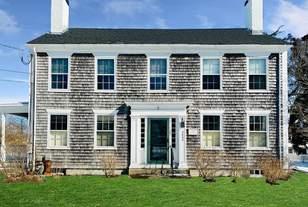Distinctive HOMES
of the East Bay & South Coast




















market for a cool $7.5 million






of the East Bay & South Coast




















market for a cool $7.5 million






New stone walls are the soul of a home in Little ComptonBY LUCY PROBERT
Stone walls and Little Compton — it’s difficult to imagine one without the other. Treasured artifacts of New England, they have lined the streets and woven through properties of this area since the 1700s, when early farmers dug stones out of the ground and used them as walls to divide their land.
When the owners of property on the Sakonnet River were planning their new home with architect Ron DiMauro, of DiMauro Architects in Newport, they knew early on that stone walls would be an integral part of their new property. “They ground a home,” says DiMauro, whose firm specializes in country and seaside homes. “We wanted to make it feel like the wall was original to the land and the house was built within it.”

In the planning and design stages, DiMauro did a lot of driving through town, taking photos of walls and studying them.
“We wanted to keep to the local stones for the new wall and make it seem like it belonged there,” he says.
Tom O’Connor, owner of O’Connor Design Build in Middletown, who along with his masons would build the wall, was first tasked with finding native stones, which as it turns out, was not an easy job.
“Every area, from Aquidneck Island to Tiverton to Little Compton, has stones that come from different veins,” he says.
“Aquidneck has more of a blue shale stone, in Tiverton it’s granite, and in Little Compton, field stone. So my search was limited to Little Compton.”
In setting out to find field stones, O’Con-
their
nor talked with a lot of local farmers, finally meeting one not far from the new property who had piles of field stones from walls he had taken down and some he was still digging up, which were all perfect for the project. “We did a little bartering for them,” says O’Connor. “He needed a wall re-built and I wanted the stone, so I re-built a wall for him in exchange for the stones.”
Using a combination of stones from the
Continued on page 8
“There is a good chance that someone else touched these very stones 100 years ago to build
own walls, so there is already a history in them, and that’s so cool and meaningful.”
RON DIMAURO, ARCHITECT
farm and larger ones from a local excavator for the base, O’Connor brought in more than a dozen truckloads for the 100 feet of wall to be built. “We were building an old farm-style wall but also one that needed to be sturdy,” he says. “It would be a hybrid of a wall that looked like it had been there a long time but would also last for 100 years.”

When it came time to build, Tom and his masons started with the foundation. Traditionally up to three feet is dug down and large heavy stones put in for stability. In this case, he says, they went down 30,” installed a stone base, then added 8 inches of concrete at the base to limit movement and built up from there. Larger stones on the bottom are battered in, or angled towards the center so that gravity would bring the wall into itself and not fall outward. The pieces then get smaller as the wall goes up but stay proportioned with the larger base stones. Larger stones are added in periodically as the wall is built, with longer flat pieces at the very top to cap it off to about a 28” to 30” height. Taking rainy and freezing weather into account, the wall was built to accommodate the elements.
The process was not a fast one, says O’Connor. “Building a new wall to look old is a unique process and something we had to adjust to,” he says. “I would bring my guys over to an old wall on the property and say, ‘It needs to look like this.’ It was a learning process for all of us. We don’t build these kinds of walls every day, and I think my team nailed it.”
Laying stones is an art, says DiMauro. “What Tom and his masons have created, knowing how to lay the stones so perfectly, it’s mesmerizing to watch.”

And the owners couldn’t be happier with what the new walls have brought to their home. “Stone walls add to the soul of a home,” says DiMauro. “There is a good chance that someone else touched these very stones 100 years ago to build their own walls, so there is already a history in them, and that’s so cool and meaningful.”

“I would bring my guys over to an old wall and say, ‘It needs to look like this.’ It was a learning process for all of us.”
TOM O’CONNOR, BUILDER

The owners turned this forgotten, historic mill house into ‘a fun place to live’
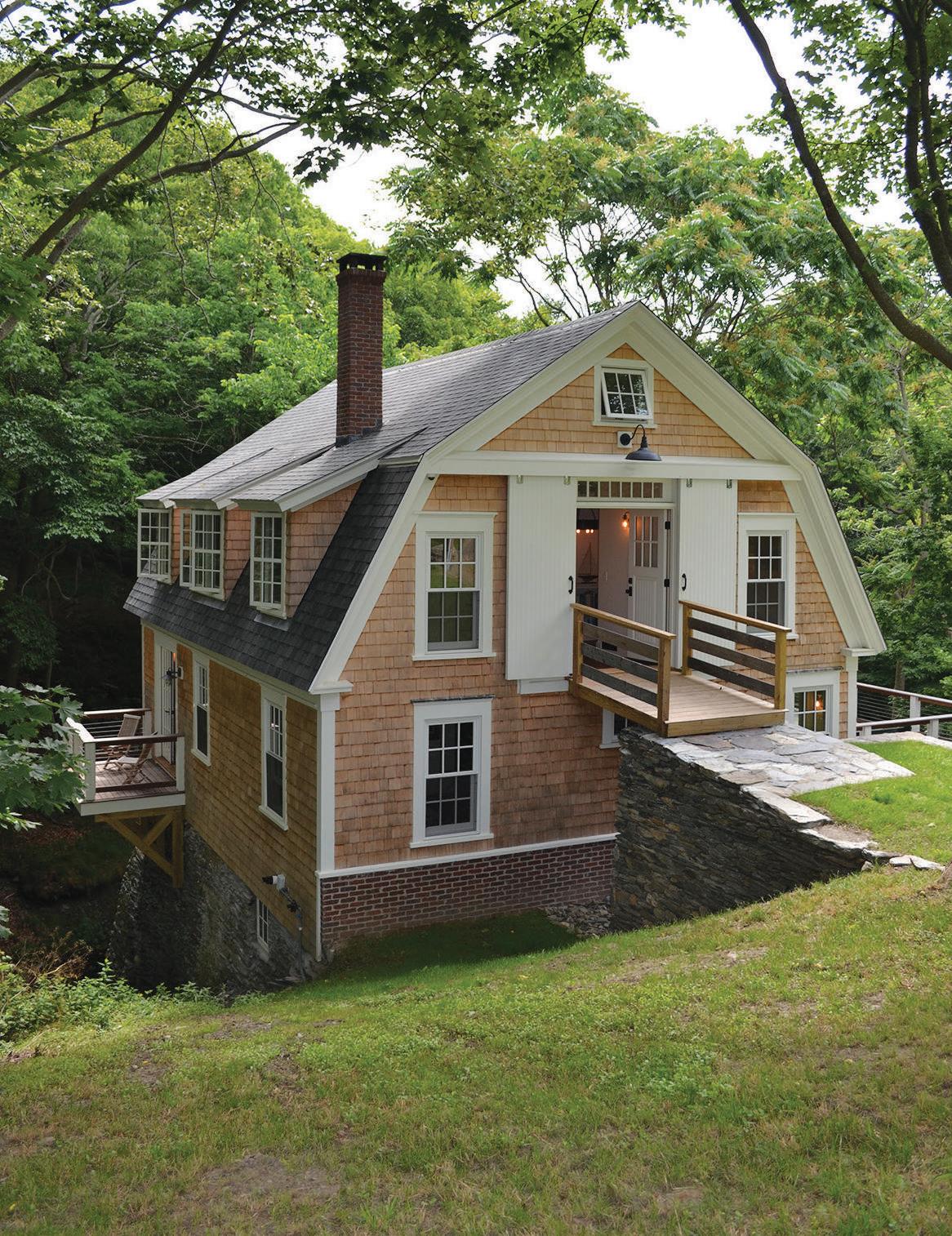
Erin and Jonathan Chapman won an historic preservation award for the redesign of their home, which once helped to power Glen Farm in Portsmouth
BY JIM MCGAWAfter stepping out of your car in Erin and Jonathan Chapman’s driveway that sits at the edge of the woods on Glen Farm Road, the first thing you hear is the peaceful rushing of water.
The sound comes from Mint Water Brook, which threads a path just around the foundation of the Chapmans’ one-of-a-kind home that’s undergone a dramatic translation since the couple first purchased the property in November 2017.

But while their home has all the conveniences of modern living — a spacious kitchen with an island, a large recessed TV over the fireplace, even an electric dumb waiter to haul firewood from the basement — it still harkens back to the past with many reminders that the building used to be known as the Glen Farm Millhouse.

“The foundation dates back to the mid-1700s; this is the second building on the foundation,” said Jonathan Chapman, who owns the property along with his wife, Erin.
Inside and out, you can’t miss the little bits of history they’ve retained: The original mill wheels were repurposed as lighting fixtures; a cast iron pulley hangs in the living room; the barn doors on the west side are exact replicas of the originals; and a large mill stone, found underneath three or four feet of dirt and mud in the basement during excavation work, is now set within the stone patio entrance outside.
“That would have been the original millstone used here years ago,” said Jonathan.
The home itself sits just above the brook, upstream from another former mill house that powered the Taylor Farm well over a century ago. On the east side, just a short walk away, are the Glen Farm Stables.
“We wanted this all in keeping with the historical nature and the barns across the street,” Jonathan said.
Added Erin, “We wanted it to fit. We didn’t want it to stand out in a weird way.”
Continued on page 12
The Chapmans’ restoration job and sensitivity to their surroundings have not gone unnoticed. The couple recently received one of the 2021 Rhody Awards for Historic Preservation from Preserve Rhode Island and the Rhode Island Historical Preservation & Heritage Commission. They won the Historic Homeowner Award for their rehabilitation of the 19th-century timber frame mill that required “structural stabilization, sweat equity, and vision to be transformed into a home.”
The Chapmans’ architect, Jack Renshaw of Clifford Renshaw Architects, had nominated them for the award, which took the couple by surprise.
“We were one of 50, I guess, and they gave out 10 awards,” Jonathan said. “We knew this was a very special place, and we put our heart and souls into it, but this is a relatively small building compared to some of the major historical sites in the states.”
Indeed, the home is less than 1,700 square feet in size, but the Chapmans took advantage of every square inch during the restoration. Storage closets


Chart House Realtors is a boutique real estate firm serving clients throughout southern New England from our office in Barrington, Rhode Island. We offer our clients a personalized experience and specialized marketing in addition to unparalleled service, support, and a vast network of resources.



If you are in the market to buy or sell real estate, we welcome the opportunity to discuss your objectives. Our team will prioritize your needs and values, utilizing a customized strategy and unmatched attention to detail to craft a plan that accomplishes your goals.

and cupboards were installed in every nook and cranny wherever possible, the outside decks provide glorious views of the trees and brook below, and there’s even a loft area where their friends’ children love to play. (The Chapmans — he’s a yacht broker, she does marketing and communications for a hospital in Boston — don’t have children as of yet.)
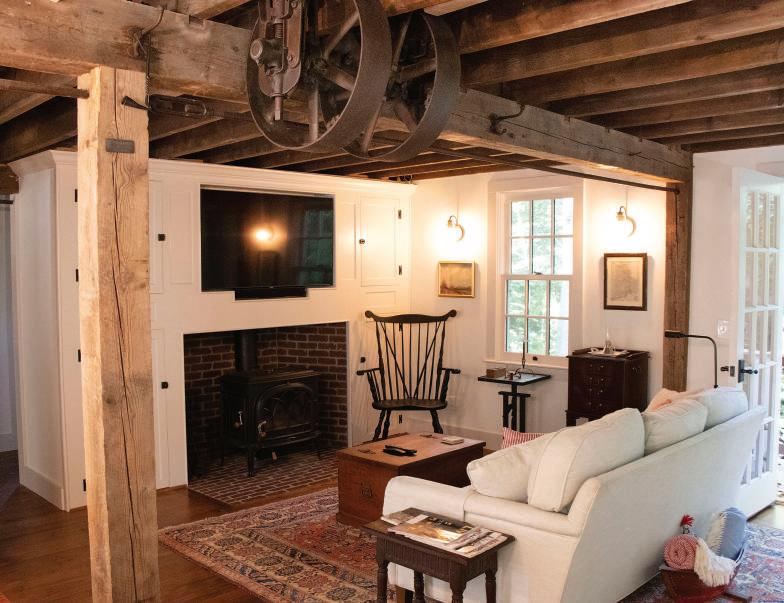


The Chapmans were originally looking for property in Newport, but couldn’t find anything they wanted that included offstreet parking, so they looked in Portsmouth. “This had three and a half acres, and we realized we could do what we wanted to do here, for the same price we’d get for a postage stamp in Newport. And, it had more character,” Jonathan said.
They first considered taking the structure down and building from scratch. “But in our conversations, we found it was going to be around the same cost as keeping the structure here, so we decided to make use of that,” said Jonathan, adding the structure is on a slope — something they’d have to deal with again if they built
Continued on page 14
something new.
“Part of it too was, if we had torn it down, they wouldn’t have allowed us to rebuild here because it was already an existing structure,” said Erin.
The former mill house was “wide open” when they bought it. It was up to the couple, along with the architect and builders, to come up with a plan to turn it into a modern home while still retaining its historic nature.

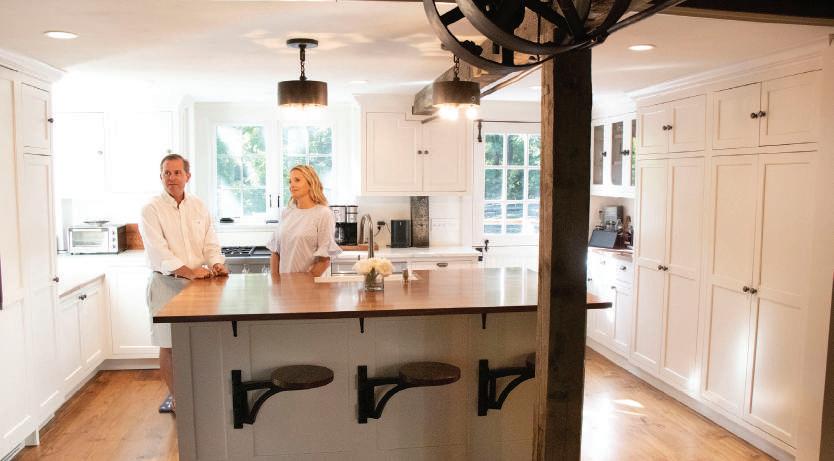
“It was, how can we keep the look to complement the rest of the neighborhood?” said Jonathan. “It wasn’t as much a restoration as it was a repurpose of an old building. We didn’t want to change much. We kind of did it on the fly with our builders.”
While they toiled on the project — the couple spent the first year and a half clearing the land themselves, and builder and preservationist Paul Strattner later gave Jonathan a crash course in shingling — they also did a deep dive into the history of the area. They read local history books and talked to Town Historian Jim Garman, even attending one of his lectures.
“The oldest roots of Portsmouth literally date back to this street,” said Jonathan. “These were originally Cundall’s Mills this mill and the other derelict mill just down the stream. I’ve got to think this area was a big part of building Portsmouth and the island.”
Many years ago, he said, the stream used to come from the direction of the horse barns just west of the home. “Underneath the building, we’ve retained the original mill raceway that spills out the back. There’s a hole in the foundation where the water used to go. That stream is what originally powered everything in here. Probably in the later 1700s, a dam was constructed and this was a big mill pond. And, at that point, I think more of the water power came from the lower mill, which was turned into a power plant for the whole farm here, which was the Taylor farm.”
Their home was once used as the primary mill for the construction of the horse barns across the street. “This predates everything over there by about 15 years,” he said. The building was also used as a grist mill for corn, while the lower mill was more for manufacturing textiles.
Like the abandoned lower mill, the Chapmans’ home had plenty of graffiti inside, presumably spray-painted by local youths over the years. “We cleaned up a lot of beer cans,” Erin said, adding that some of the graffiti still remains upstairs.
Now that their hard work is nearly done — there are a few cosmetic issues the couple is still addressing — Erin and Jonathan can sit back and enjoy the fruits of their labor.
“We were blessed to be able to have the time and the resources to do it,” Erin said of the project. “I love pulling in here at night, and knowing our home is something we worked so hard on building together. In the winter, having that fire roaring makes it so cozy. I just love the uniqueness of it.”
Added Jonathan, “There’s nothing like the Glen anywhere
on the island, and it feels like you’re so far into the country and you’re so remote, but you’re 15 minutes from Newport.”
Neighbors have been receptive to the transformation of the old mill, Erin said. “So many people walk up and down the road, ride their bikes, and stop and chat, saying, ‘We’ve been watching the progress,’ or, ‘We’ve always wanted to do this,’” she said.
“It’s a fun place to live,” added Jonathan.
The Chapmans not only took over and restored an important
piece of local history, they’re now part of it. To that end, they gathered up some of the documents related to their project — a newspaper article noting the property transaction, architectural drawings, pictures and more — so the next tenants will know a little bit about how their home came to be.
“We actually put together a little time capsule with some history of the project,” said Erin. “It’s hidden in one of these walls somewhere. When the time comes, somebody will find it when we’re long gone.”



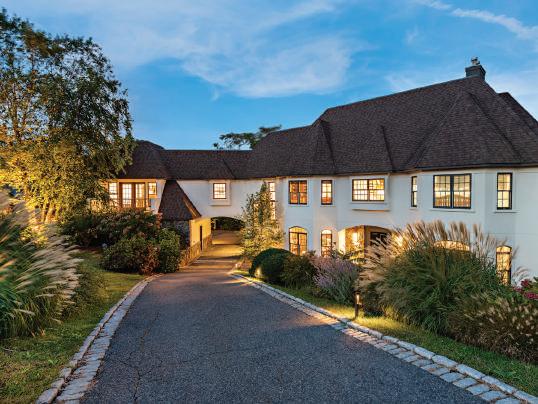
Forty years ago when we started Residential Properties Ltd., everyone thought we were crazy.

Then something happened.
People noticed that we had a different approach. We created new levels of service and we worked harder and smarter than everyone else ... and we still do!
Other agents saw how quickly we were transforming the business and wanted to join us and grow.

We embraced technology early and our awardwinning website has been ranked as one of the top real estate sites in the country.
We now have 9 offices, a relocation division and a full service in-house marketing department with professional videographers and photographers.
Our 265 agents are among the most knowledgeable in the business who will strive to provide a positive, satisfying and professional experience whether you’re buying or selling.
One thing that hasn’t changed is the Residential Properties experience ... our commitment to service and innovation and our thanks for making us your trusted choice.
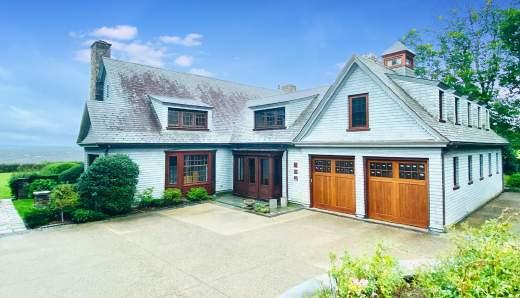






While the pandemic has wreaked havoc on many industries, it’s been a catalyst for the luxury real estate market. Demand and prices soared in 2020, and they continued soaring in 2021.

Will it continue in 2022?
Some local experts believe not much will change next year. There may be a slowdown in the demand from out-of-state buyers, but all the other factors — low mortgage rates, high demand for the beautiful regions of the East Bay and Southcoast, increased savings, and a shortage of inventory — will fuel a very similar market in 2022.
David Coleman, office manager at Mott & Chace Sotheby’s International Realty, and a real estate professional in business for more than 40 years, believes the local market will not change much in 2022.
“I think indicators are that inventory will stay low, but so will interest rates. One of the biggest impacts we’ve had on the mar-
ket has been the interest, not only from out-of-town buyers, but from out of state buyers. Homes that have been updated always seem to get immediate interest, with multiple offers, and homes that haven’t been updated tend to stay on the market a bit longer, as buyers are hesitant to do a project with today’s construction costs — never mind trying to find a contractor.”
Buyers from other states accounted for 24.8 percent of total residential sales in Rhode Island in the second quarter of 2021, but the rates were even higher — more than 31 percent — in Bristol and Newport counties. Most buyers are coming from Massachusetts, New York and Connecticut. In the luxury market, buyers from outside of Rhode Island accounted for half of all properties sold for $1 million or more. Coastal markets saw an even higher influx of out-of-state buyers.
Lisa Schryver and Elizabeth Kirk of the
Kirk Schryver Team at Residential Properties are similarly optimistic about the coming year.
“We feel the East Bay market will continue to be strong across all price points — especially if the property is in good condition, a desirable location and is priced accurately,” Kirk said. “The properties we see sitting are those that are priced too aggressively, even for this strong market. ‘The less you ask, the more you get,’ holds very true. An accurate price brings buyers. While we don’t believe prices will continue to accelerate as they have been — almost 20 percent increases in Rhode Island, which marks the second-highest in all of New England — we do believe our market will continue to see multiple offers and faster sales.”
The East Bay offers a lifestyle that is incredibly appealing, especially to people coming from larger, more expensive markets, she said.
“It always comes down to location, condition and price,” Schryver said. “Recently
Local experts predict the 2022 market will look a lot like it has — high prices and high demand for the region’s best homes
we listed 6 College Lane in Barrington for $649,000 and had 19 showings on Saturday and eight offers by the Sunday deadline. The house was recently renovated, and my clients have exquisite taste and the home showed beautifully. All the potential buyers loved the layout, large yard and thoughtful updates. A listing in this condition in this price point is a rarity in Barrington.”

“2022 will present another strong year for our local housing market,” said Jennifer Mello, broker with The Mello Group. “Although inventory has started to rise slowly, it is not enough to fulfill the needs of our local buying demands. This fact, paired with low interest rates and increased buyer activity for resale inventory, will keep things moving at a steady pace and high level.”
Mello sees more of the same for 2022.
“Although values may not increase at the same peak growth rates experienced in 2021, I don’t believe that a ‘bubble’ will pop, and all that has gained will not be lost. It is still an exceptionally good time to sell real estate, and purchasing makes great sense for many. Real estate continues to be one of the best ways to build wealth and will remain true through 2022.”

Providing more evidence of how hot the luxury market has been this year … This home near Poppasquash Point in Bristol listed for what seemed like an unreasonable price, nearly $8 million. It sold in a matter of months for nearly $7 million — $6,875,000, to be exact. William Raveis represented the sellers, and Gustave White Sotheby’s represented the buyers.

Natural greenery, especially blending multiple styles, can bring life to any table or home. Says the designer: “For the table, it’s all about height and color variation. That doesn’t mean going overboard with color, but maybe adding a couple of wood tones with white and some green or red mixed in.”

Simple, elegant and naturally green – here are 8 tips to deck your halls in style
 BY LUCY PROBERT
BY LUCY PROBERT
Holly berries, evergreen boughs, mistletoe, kissing balls. With the holidays fast approaching, it’s time to deck the halls with greenery, the best way to make your home feel fresh and festive. We asked Erika Twohig of Pickle & Board Interiors in Barrington for tips on decorating for the holiday season and making it fun.

1. Start with Greens: “After Thanksgiving, my Pickle & Board partner Julie Sanfilippo and I love shopping for basic greens for our homes at Trader Joe’s. They have such great evergreens and sell them in small packs so you can mix and match. We have completely different styles, so it’s always fun to see what we end up picking. We both start with our greens in water in a classic vase on the table and from there we layer in other elements such as a table runner, ribbons or more greens with sparkle and glitz.
“Because they’re fresh, they add a wonderful scent. For me there is nothing better than the smell of pine and balsam fir, those are my favorites. Then I’ll add little elements like holly berries as we get closer to Christmas. We also love putting greens on the mantle and bookshelves, sometimes weaving in small battery-operated fairy lights to create a mood.”
2. Layering and Grouping: “For the table, it’s all about height and color variation. That doesn’t mean going overboard with color, but maybe adding a couple of wood tones with white and some green or red mixed in looks beautiful.
“And if you want to add items on a mantle or table, like small wooden trees or snowflakes, we don’t suggest mixing and matching; a small grouping of 2 or 3 of the same items is better, maybe in differing heights. We also love layering in tapered candles and candlesticks.”
3. Ornamental Faves: “I have a tradition with my family where every Halloween, when we get our pumpkins, I look for an ornament for the tree but also to use in a tablescape or in a dish or a bowl. I look for either a vintage style ornament or one that really makes a
statement, like a large ball or snowflake, something that you can layer in with other elements that you already have. It’s about using your own special things and mixing in a few statement pieces.”
4. Decorate Your Chandelier: “If you’re having a lot of people over for a holiday dinner and space on the table is limited, consider trimming your chandelier instead of using a centerpiece. One year I took several deep red glittery holiday balls from our tree and hung them up on the chandelier. Weave some greens in, and it’s really a great way to decorate.”
5. Wreaths: “I buy evergreen wreaths every year for my family’s home, and I like to keep it really simple by adding only a single ribbon, maybe plaid, or whatever I’m in the mood for that year, and tying it on the top.

“Sometimes I look on Pinterest for different bow styles, but it’s usually just a basic one. I love a simple wreath; they’re just so fresh. I also have faux wreaths that I have on the inside of my doors so I’m not only decorating the exterior of the doors but the inside as well.”
6. Kissing Balls: “Julie loves hanging a couple of the evergreen and pinecone kissing balls on her front porch, and they’re just so sweet.”

7. Stagger Decorating: “People can find it overwhelming putting up their decorations all in one day. What I do with my kids, which is really fun, is we’ll start bringing up our holiday bins for fall and harvest season in October and then just start layering in holiday decorations and swapping out as we get into December. It’s ok to start early, to put out some evergreens when the weather gets cooler and save the super ornamental décor for closer to the holiday.
“It’s an enjoyable way to feel festive throughout the season, and it’s also a good way to make your house feel less cluttered.
“Finally, to make the feeling last, I’ll keep the greenery on my mantle with twinkle lights probably until February or March. I just love looking at them.”
8. Support Local Fundraising Groups: “Many schools and charitable organizations offer greenery and trees for sale around the holidays as fundraisers, and it’s a great way to support local causes. If a student doesn’t come knocking on your door to sell them, you can often find information on how to order on your town’s Facebook page.”






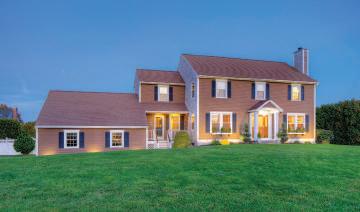
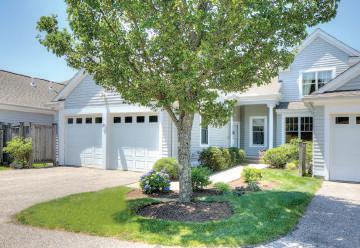

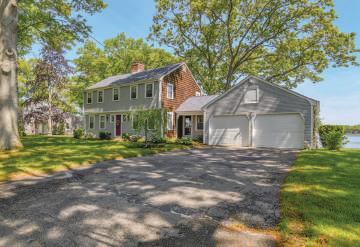
So many buyers, so little inventory. Skyrocketing prices and a shortage of existing homes for sale have led some buyers to investigate whether they should build a home instead of getting caught up in bidding wars.
It makes sense, but many of these buyers become disheartened when they realize that quotes are high, and the building timeline can exceed their expectations by a year or more. Associated General Contrac-
Could modular homes and their quick construction timelines fill the gap in a market with extremely low inventory?
tors of America released their October “Construction Inflation Alert,” which warns that there are currently “delays at every stage of the supply chain.” The report also states that, while some prices have come down, there is “continued volatility in material costs, as well as lengthening lead times for both production and deliveries.”
Everything from lumber and gypsum drywall, to fixtures and appliances have been affected.
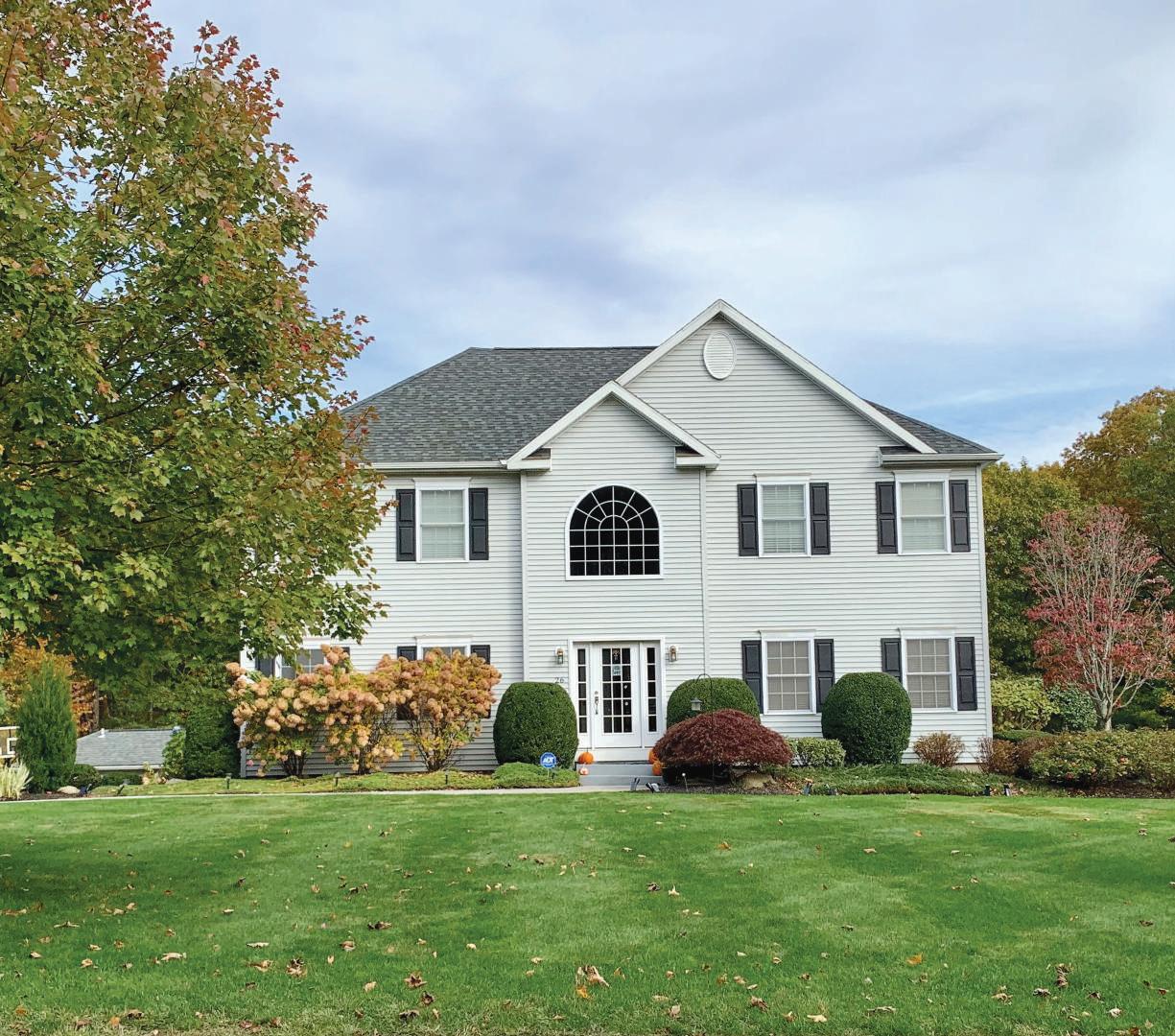
While engineering and approval delays can’t be avoided, a few buyers are shorten-
ing the timeline by building modular homes. In fact, the Northeast is now leading the way in modular sales. According to the National Association of Home Builders website, “5% of the region’s 57,000 housing units completed were due to modular construction, the highest share in the country.”
In the past, modular homes offered few options for customization and, because of
Continued on page 26
1.990%



their “cookie-cutter” appearance, received lackluster enthusiasm from buyers. With advances in technology and technique, that has changed significantly. Modular builders now offer homes of all sizes with fully customizable floor plans and finishes.







Impresa Modular, a national modular builder based in West Virginia, offers an interactive tool that allows buyers to design a home from the comfort of their laptop.
Another reason that consumers have been slow to warm up to modular construction is that they often confuse modular with manufactured homes. Manufactured homes are built in one piece and moved on their own frame to the site. They are affordable and a great choice for those with a tight budget, but they are not considered to be “real” property.

Modular homes, which take on average 6 to 10 weeks to build, are built by contractors in a controlled factory environment. They are completed in sections, or modules, and then transported to the lot in pieces, where the foundation and engineering work has already been completed.
Once there, the sections are “set” by a Crews assemble sections of a

crane and joined and finished by professional installers. Once there, these homes are subject to the same codes, standards and inspections as conventional stick-built homes
Like elsewhere, prices are rising What about material shortages and price increases — aren’t modular builders affected as well? While material costs have gone up worldwide, modular builders purchase everything from lumber to fixtures and appliances in bulk. This has helped them to avoid shortages as well as keep construction costs lower than traditional builds.


Kelly Ambrosino, of Providence-based Modular Home Concepts, is a dealer for Champion Homes, New Era Building Systems and Skyline. She says that, while they aren’t experiencing shortages, the sharp increase in building material costs did eventually filter into modular construction prices. Her manufacturers implemented an October surcharge which led to an overall price increase of about 20-25%, which is in-line with traditional build price increases.
While the efficiency is a benefit for some, the biggest advantage for most buyers who
choose to go modular is the shorter construction timeline. Ambrosino says they are “running five months out for delivery, from time of order.” She says that, for buyers who have the land and approvals ready, they expect “homes ordered in October to be completed in March, and homes ordered in November to be delivered in April.”

Because these homes are built in a controlled environment, they can begin production at the factory while the land and foundation are being prepared. New England weather is always a consideration when building, so delays due to weather are reduced and would only be a consideration during the sitework and foundation preparation.
This shortened timeline can lead to other savings. According to Daniel Briand, president & CEO of BayCoast Mortgage Company, mortgages for modular homes are “similar to traditional construction loans, but with a different disbursement schedule.” Briand says that with modular, it’s very convenient to finance the land and home together and, because of the shorter timeline, buyers save on financing costs. He notes that buyers should be aware of insurance requirements: “Insurance is a
key component because buyers take delivery at the site. They should be aware of who is expected to insure the units at each stage of the process.”

With so much uncertainty in the world, even homeowners who are ready to move have been slow to list. Many cite fear of finding a place to go as their main concern. This, along with low interest rates, has caused a backlog of buyers, who are driving up home prices by offering tens of thousands of dollars above asking price in an attempt to “win” the home. While traditional builders are trying hard to meet the need, they have had to deal with high demand, drastically fluctuating material prices, shortages, and a soft labor market. This has been a frustrating time for many homebuyers, especially those who are anxious to settle into a home.
While no one can say what the future brings, house lots are available. At the beginning of November, there were approximately 80 lots for sale in the East Bay area versus only 180 homes for sale. For buyers who find the right lot and can wait a few months, modular homes might shake loose the supply chain bottleneck.






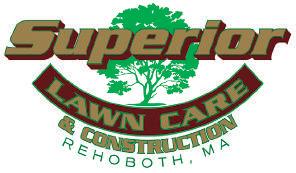
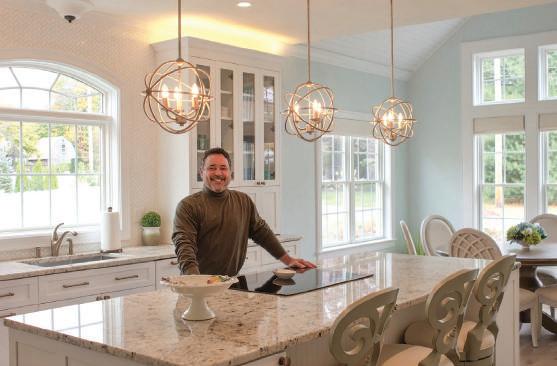












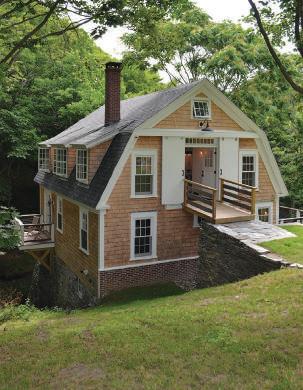
With 11 bedrooms, 12 bathrooms and more than 13,500 square feet, the property located at 333 Poppasquash Road, most recently known as Point Pleasant Inn, is on the market with an asking price of $7,500,000. It’s a remarkable property, with its origins in one of 19th- and 20th-century Bristol’s most illustrious merchant families.


Charles Bristed Rockwell built the twoand-a-half-story Tudor Revival country house in 1937-1938 on some 50 acres of farmland on Poppasquash Point. Named for the Nathaniel Byfield 1680s dwelling that stood to the south, it is believed that the Rockwells began living at Point Pleasant on the same day that the 1938 hurricane struck.
Charles B. Rockwell was the son of Charles Rockwell, who, among other things, owned Namquit Mill, on the site of what is now the Robin Rug complex at the southern end of Thames Street. Described by local historian Richard V. Simpson as “an able and conscientious executive, sound in judgment and capable in the direction of large affairs,” Rockwell Sr. was involved in a great many local endeavors, including director of the Bristol Branch of the Industrial Trust Co., The Young Men’s Christian Association Building, Rockwell Hall, the M.B.S. Rockwell Convalescent House, the old DeWolf Inn plot on Thames Street (now Rockwell Park), the town council, and St. Michael’s Church.
As the heir to his father’s successes and obligations, Charles B. Rockell is said to have sited his new home directly across the harbor from Namquit Mill, in order to have a good view of work from home, and vice-versa.
The house was designed by Wallis Howe, an architect with deep Bristol roots whose career spanned from 1894 to 1960. Among the many local buildings credited to Howe and his associates are the Bristol Armory (now Maritime Center), St. Martin’s Church, the Old Stone Bank, and Rochambeau Library in Providence; Astor Hall at St. George’s School, and Barrington Public Library.
The original landscaping was designed by prolific landscape designer Fletcher Steele, who created more than 700 gardens from 1915 to 1971. Steele is known for bridging the transition from Beaux Arts formalism to modern landscape design, and he believed
that landscape architecture was an art form on par with painting or music. His most famous work is the Naumkeag estate in Stockbridge, Mass.
Bristol resident Gina Macdonald recalls being so impressed by the property, which she first spotted while sailing on Bristol Harbor as a college student in the late 1960s, that she told her parents about it. Her parents, James and Jean Macdonald, offered $150,000 sight unseen, a price that was rejected, despite the fact that “you could buy a mansion in Newport for $100,000 in those days,” Macdonald said. Four months later, the realtor contacted the Macdonalds and told them the property was theirs, if they would sweeten the deal to $160,000. In the 50-plus years since then, the property has had two additional owners.
In a sale that would rank among the highest in Bristol’s history, historic Point Pleasant hits the marketA view from one of the 11 bedrooms, facing out to Bristol Harbor and Narragansett Bay.


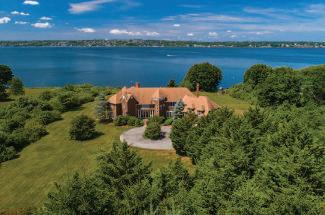

Milbury and Company extends its congratulations to the buyers and sellers of these and many other fine properties, as well as the customers and clients that we have been so fortunate to work with during this extraordinarily successful year. THANK YOU for choosing us and for helping to make Milbury and Company the South Coast’s NUMBER ONE brokerage of distinctive properties!






Happy Holidays from all of us at Milbury and Company!



